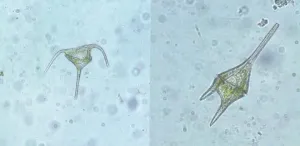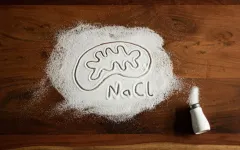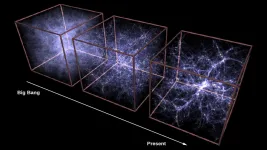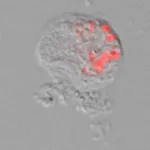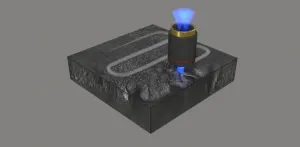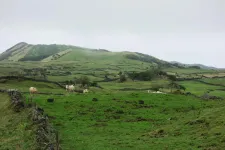A physical and chemical sedimentary record of Laramide tectonic shifts in the Cretaceous-Paleogene San Juan Basin, New Mexico, USA Kevin M. Hobbs; Peter J. Fawcett Abstract: Fluvial siliciclastic rocks bracketing the Cretaceous-Paleogene (K-Pg) boundary in the San Juan Basin, New Mexico (USA), provide records of regional fluvial and tectonic evolution during the Laramide orogeny. Petrographic analyses of sandstones from the Upper Cretaceous Fruitland Formation and Kirtland Formation and the Paleocene Ojo Alamo Sandstone and Nacimiento Formation show that the rivers depositing these sediments were sourced in areas where unroofing of crystalline basement rocks took place, introducing an increasing proportion of immature detrital grains into the fluvial system through time. After the Cretaceous-Paleogene boundary, rivers deposited an increasing amount of microcline and orthoclase feldspar relative to plagioclase feldspar, suggesting a growing source in unique crystalline basement rocks. Geochemical analyses show significant differences between Al- and K-poor Upper Cretaceous sandstones and Al- and K-rich lower Paleocene sandstones in the San Juan Basin. The high proportion of sand-sized material in the Ojo Alamo Sandstone suggests that it was deposited in a basin with a low ratio of sediment supply to accommodation. However, magnetostratigraphic age constraints suggest it had a relatively high sedimentation and/or subsidence rate of as much as 0.38 m/k.y. The sediment supply must have been high in order to deposit a basin-wide coarse sand-dominated package, suggesting rapid creation of topographic relief in the San Juan uplift, the proposed source area of the Ojo Alamo fluvial system. The observed sedimentary architecture and age constraints of the Ojo Alamo Sandstone, including kilometers-wide sand bodies and limited overbank mudstones throughout most of the outcrop area, are difficult to reconcile with accepted models of aggradation and avulsion in large fluvial systems, but available age and lithologic data make difficult a complete understanding of Paleocene San Juan Basin fluvial systems and basin evolution. Here, we present new lithologic, petrographic, and thickness data from San Juan Basin K-Pg fluvial siliciclastic units and interpretations of their origins. View article: https://pubs.geoscienceworld.org/gsa/geosphere/article-abstract/doi/10.1130/GES02324.1/596304/A-physical-and-chemical-sedimentary-record-of
The spatial and temporal evolution of the Portland and Tualatin forearc basins, Oregon, USA Darby P. Scanlon; John Bershaw; Ray E. Wells; Ashley R. Streig Abstract: The Portland and Tualatin basins are part of the Salish-Puget-Willamette Lowland, a 900-km-long, forearc depression lying between the volcanic arc and the Coast Ranges of the Cascadia convergent margin. Such inland seaways are characteristic of warm, young slab subduction. We analyzed the basins to better understand their evolution and relation to Coast Range history and to provide an improved tectonic framework for the Portland metropolitan area. We model three key horizons in the basins: (1) the top of the Columbia River Basalt Group (CRBG), (2) the bottom of the CRBG, and (3) the top of Eocene basement. Isochore maps constrain basin depocenters during (1) Pleistocene to mid-Miocene time (0-15 Ma), (2) CRBG (15.5-16.5 Ma), and (3) early Miocene to late Eocene (ca. 17-35 Ma) time. Results show that the Portland and Tualatin basins have distinct mid-Miocene to Quaternary depocenters but were one continuous basin from the Eocene until mid-Miocene time. A NW-striking gravity low coincident with the NW-striking, fault-bounded Portland Hills anticline is interpreted as an older graben coincident with observed thickening of CRBG flows and underlying sedimentary rocks. Neogene transpression in the forearc structurally inverted the Sylvan-Oatfield and Portland Hills normal faults as high-angle dextral-reverse faults, separating the Portland and Tualatin basins. An eastward shift of the forearc basin depocenter and ten-fold decrease in accommodation space provide temporal constraints on the emergence of the Coast Range to the west. Clockwise rotation and northward transport of the forearc is deforming the basins and producing local earthquakes beneath the metropolitan area. View article: https://pubs.geoscienceworld.org/gsa/geosphere/article-abstract/doi/10.1130/GES02298.1/596305/The-spatial-and-temporal-evolution-of-the-Portland
Petrogenesis of the 91-Mile peridotite in the Grand Canyon: Ophiolite or deep-arc fragment? S.J. Seaman; M.L. Williams; K.E. Karlstrom; P.C. Low Abstract: Recognition of fundamental tectonic boundaries has been extremely difficult in the (>1000-km-wide) Proterozoic accretionary orogen of southwestern North America, where the main rock types are similar over large areas, and where the region has experienced multiple postaccretionary deformation events. Discrete ultramafic bodies are present in a number of areas that may mark important boundaries, especially if they can be shown to represent tectonic fragments of ophiolite complexes. However, most ultramafic bodies are small and intensely altered, precluding petrogenetic analysis. The 91-Mile peridotite in the Grand Canyon is the largest and best preserved ultramafic body known in the southwest United States. It presents a special opportunity for tectonic analysis that may illuminate the significance of ultramafic rocks in other parts of the orogen. The 91-Mile peridotite exhibits spectacular cumulate layering. Contacts with the surrounding Vishnu Schist are interpreted to be tectonic, except along one margin, where intrusive relations have been interpreted. Assemblages include olivine, clinopyroxene, orthopyroxene, magnetite, and phlogopite, with very rare plagioclase. Textures suggest that phlogopite is the result of late intercumulus crystallization. Whole-rock compositions and especially mineral modes and compositions support derivation from an arc-related mafic magma. K-enriched subduction-related fluid in the mantle wedge is interpreted to have given rise to a K-rich, hydrous, high-pressure partial melt that produced early magnetite, Al-rich diopside, and primary phlogopite. The modes of silicate minerals, all with high Mg#, the sequence of crystallization, and the lack of early plagioclase are all consistent with crystallization at relatively high pressures. Thus, the 91-Mile peridotite body is not an ophiolite fragment that represents the closure of a former ocean basin. It does, however, mark a significant tectonic boundary where lower-crustal arc cumulates have been juxtaposed against middle-crustal schists and granitoids. View article: https://pubs.geoscienceworld.org/gsa/geosphere/article-abstract/doi/10.1130/GES02302.1/596306/Petrogenesis-of-the-91-Mile-peridotite-in-the
Secular variations of magma source compositions in the North Patagonian batholith from the Jurassic to Tertiary: Was mélange melting involved? Antonio Castro; Carmen Rodriguez; Carlos Fernández; Eugenio Aragón; Manuel Francisco Pereira ... Abstract: This study of Sr-Nd initial isotopic ratios of plutons from the North Patagonian batholith (Argentina and Chile) revealed that a secular evolution spanning 180 m.y., from the Jurassic to Neogene, can be established in terms of magma sources, which in turn are correlated with changes in the tectonic regime. The provenance and composition of end-member components in the source of magmas are represented by the Sr-Nd initial isotopic ratios (87Sr/86Sr and 143Nd/144Nd) of the plutonic rocks. Our results support the interpretation that source composition was determined by incorporation of varied crustal materials and trench sediments via subduction erosion and sediment subduction into a subduction channel mélange. Subsequent melting of subducted mélanges at mantle depths and eventual reaction with the ultramafic mantle are proposed as the main causes of batholith magma generation, which was favored during periods of fast convergence and high obliquity between the involved plates. We propose that a parental diorite (= andesite) precursor arrived at the lower arc crust, where it underwent fractionation to yield the silicic melts (granodiorites and granites) that formed the batholiths. The diorite precursor could have been in turn fractionated from a more mafic melt of basaltic andesite composition, which was formed within the mantle by complete reaction of the bulk mélanges and the peridotite. Our proposal follows model predictions on the formation of mélange diapirs that carry fertile subducted materials into hot regions of the suprasubduction mantle wedge, where mafic parental magmas of batholiths originate. This model not only accounts for the secular geochemical variations of Andean batholiths, but it also avoids a fundamental paradox of the classical basalt model: the absence of ultramafic cumulates in the lower arc crust and in the continental crust in general. View article: https://pubs.geoscienceworld.org/gsa/geosphere/article-abstract/doi/10.1130/GES02338.1/596307/Secular-variations-of-magma-source-compositions-in
Fast Pliocene integration of the Central Anatolian Plateau drainage: Evidence, processes, and driving forces Gilles Y. Brocard; Maud J.M. Meijers; Michael A. Cosca; Tristan Salles; Jane Willenbring ... Abstract: Continental sedimentation was widespread across the Central Anatolian Plateau in Miocene-Pliocene time, during the early stages of plateau uplift. Today, however, most sediment produced on the plateau is dispersed by a well-integrated drainage and released into surrounding marine depocenters. Residual long-term (106-107 yr) sediment storage on the plateau is now restricted to a few closed catchments. Lacustrine sedimentation was widespread in the Miocene-Pliocene depocenters. Today, it is also restricted to the residual closed catchments. The present-day association of closed catchments, long-term sediment storage, and lacustrine sedimentation suggests that the Miocene-Pliocene sedimentation also occurred in closed catchments. The termination of sedimentation across the plateau would therefore mark the opening of these closed catchments, their integration, and the formation of the present-day drainage. By combining newly dated volcanic markers with previously dated sedimentary sequences, we show that this drainage integration occurred remarkably rapidly, within 1.5 m.y., at the turn of the Pliocene. The evolution of stream incision documented by these markers and newly obtained 10Be erosion rates allow us to discriminate the respective contributions of three potential processes to drainage integration, namely, the capture of closed catchments by rivers draining the outer slopes of the plateau, the overflow of closed lakes, and the avulsion of closed catchments. Along the southern plateau margin, rivers draining the southern slope of the Central Anatolian Plateau expanded into the plateau interior; however, only a small amount of drainage integration was achieved by this process. Instead, avulsion and/or overflow between closed catchments achieved most of the integration, and these top-down processes left a distinctive sedimentary signal in the form of terminal lacustrine limestone sequences. In the absence of substantial regional climate wetting during the early Pliocene, we propose that two major tectonic events triggered drainage integration, separately or in tandem: the uplift of the Central Anatolian Plateau and the tectonic completion of the Anatolian microplate. Higher surface uplift of the eastern Central Anatolian Plateau relative to the western Central Anatolian Plateau promoted more positive water balances in the eastern catchments, higher water discharge, and larger sediment fluxes. Overflow/avulsion in some of the eastern catchments triggered a chain of avulsions and/or overflows, sparking sweeping integration across the plateau. Around 5 Ma, the inception of the full escape of the Anatolian microplate led to the disruption of the plateau surface by normal and strike-slip faults. Fault scarps partitioned large catchments fed by widely averaged sediment and water influxes into smaller catchments with more contrasted water balances and sediment fluxes. The evolution of the Central Anatolian Plateau shows that top-down processes of integration can outcompete erosion of outer plateau slopes to reintegrate plateau interior drainages, and this is overlooked in current models, in which drainage evolution is dominated by bottom-up integration. Top-down integration has the advantage that it can be driven by more subtle changes in climatic and tectonic boundary conditions than bottom-up integration. View article: https://pubs.geoscienceworld.org/gsa/geosphere/article-abstract/doi/10.1130/GES02247.1/595917/Fast-Pliocene-integration-of-the-Central-Anatolian
Postcaldera intrusive magmatism at the Platoro caldera complex, Southern Rocky Mountain volcanic field, Colorado, USA Amy K. Gilmer; Ren A. Thompson; Peter W. Lipman; Jorge A. Vazquez; A. Kate Souders Abstract: The Oligocene Platoro caldera complex of the San Juan volcanic locus in Colorado (USA) features numerous exposed plutons both within the caldera and outside its margins, enabling investigation of the timing and evolution of postcaldera magmatism. Intrusion whole-rock geochemistry and phenocryst and/or mineral trace element compositions coupled with new zircon U-Pb geochronology and zircon in situ Lu-Hf isotopes document distinct pulses of magma from beneath the caldera complex. Fourteen intrusions, the Chiquito Peak Tuff, and the dacite of Fisher Gulch were dated, showing intrusive magmatism began after the 28.8 Ma eruption of the Chiquito Peak Tuff and continued to 24 Ma. Additionally, magmatic-hydrothermal mineralization is associated with the intrusive magmatism within and around the margins of the Platoro caldera complex. After caldera collapse, three plutons were emplaced within the subsided block between ca. 28.8 and 28.6 Ma. These have broadly similar modal mineralogy and whole-rock geochemistry. Despite close temporal relations between the tuff and the intrusions, mineral textures and compositions indicate that the larger two intracaldera intrusions are discrete later pulses of magma. Intrusions outside the caldera are younger, ca. 28-26.3 Ma, and smaller in exposed area. They contain abundant glomerocrysts and show evidence of open-system processes such as magma mixing and crystal entrainment. The protracted magmatic history at the Platoro caldera complex documents the diversity of the multiple discrete magma pulses needed to generate large composite volcanic fields. View article: https://pubs.geoscienceworld.org/gsa/geosphere/article-abstract/doi/10.1130/GES02242.1/595918/Postcaldera-intrusive-magmatism-at-the-Platoro
GEOSPHERE articles are available at https://geosphere.geoscienceworld.org/content/early/recent. Representatives of the media may obtain complimentary copies of GEOSPHERE articles by contacting Kea Giles at the address above. Please discuss articles of interest with the authors before publishing stories on their work, and please refer to GEOSPHERE in articles published. Non-media requests for articles may be directed to GSA Sales and Service, gsaservice@geosociety.org.
https://www.geosociety.org/
INFORMATION:
